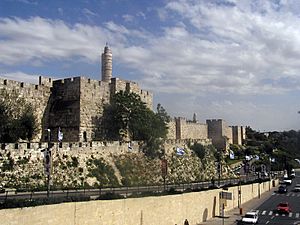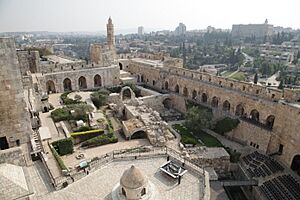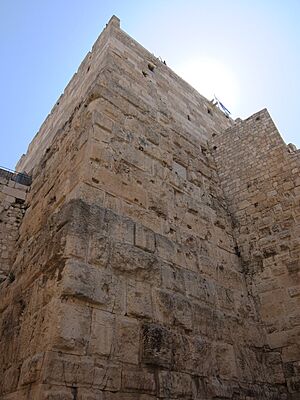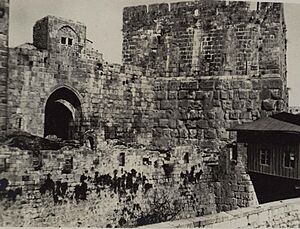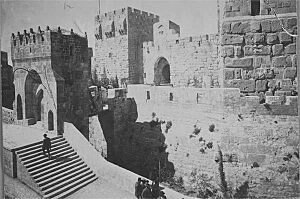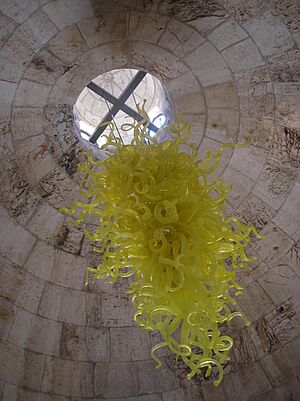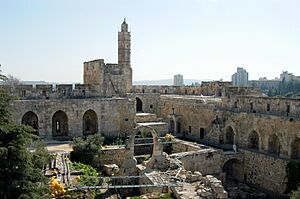Tower of David facts for kids
The Tower of David, also called the Citadel, is an ancient fortress and a modern museum. It stands near the Jaffa Gate entrance to the Old City in Jerusalem.
The fortress you see today was built during the Mamluk and Ottoman times. It was constructed on top of older forts from the Hasmonean, Herodian, Byzantine, and early Muslim periods. These older forts were often destroyed during wars, especially during the Crusades.
Inside the Tower of David, you can find amazing things from long ago. There are items from the Iron Age, like an old stone quarry from the Second Temple period. You can also see pottery and other finds from the First Temple Period. Today, the Tower of David is a place for fun events, art shows, concerts, and cool sound-and-light shows.
An archaeologist named Dan Bahat explains that Herod changed the original three towers built by the Hasmoneans. He says that the tower in the northeast became much bigger. This large tower was first called the 'Tower of David' around the 5th century CE. Later, in the 1800s, the name 'Tower of David' started to refer to the tall minaret (a tower for prayer calls) built in the 1600s. Since 1967, the name officially means the entire fortress.
Contents
What's in a Name?
Why "Tower of David"?
The name Tower of David was first used for one of Herod's towers in the 5th century CE. This was by Byzantine Christians. They believed this spot was the palace of the famous King David.
They got the name from a Bible book called the Song of Songs. This book is thought to be written by Solomon, King David's son. It says: "Your neck is like the tower of David built for an armoury, where a thousand shields hang."
Arabic Names
The large tower in the northeast of the citadel has an Arabic name: Burj al-Qalʾa. This means "Citadel Tower."
In early Muslim times, it was also known as Miḥrāb Dāwūd. This means "David's prayer place." There is another prayer place with a similar name inside the Haram esh-Sharif/Temple Mount.
A Look Back: History of the Citadel
Early Beginnings: Hasmonean Period
Around 200 BCE, the Old City of Jerusalem grew bigger. It expanded onto a high hill called the Western Hill. This hill is about 773 meters (2,536 feet) high. It has steep valleys on all sides except the north.
The first settlement here was around 150 BCE. This was during the time of the Hasmonean kings. They built what was called "the First Wall" to protect the city.
Herod's Strong Towers
Herod took control from the Hasmonean family. Between 37 and 34 BCE, he added three huge towers to the city's defenses. He built them at the vulnerable northwest corner of the Western Hill. This is where the citadel stands today.
Herod wanted to protect the city and his own royal palace. His palace was located nearby on Mount Zion. He named the tallest tower, 44 meters (144 feet) high, Phasael. This was in memory of his brother who had died. Another tower was named Mariamne, after his second wife. The third tower was called Hippicus, after a friend.
Today, only the base of one of these towers remains. It is either the Phasael or the Hippicus Tower. About 16 layers of Herod's original large stones are still visible. Smaller stones were added on top later, making the tower taller.
Roman Times
During the Jewish war with Rome, a leader named Simon bar Giora lived in the tower. After the Romans destroyed Jerusalem in 70 CE, they kept the three towers. They wanted them to show how strong the Roman army was. The site then became a place for Roman soldiers to live.
When the Roman Empire became Christian in the 4th century, monks settled in the citadel. During this Byzantine period, the remaining Herodian tower got its new name: the Tower of David. The Byzantines mistakenly thought the hill was Mount Zion. They believed it was David's palace, as mentioned in the Bible.
Muslim and Crusader Times
After the Siege of Jerusalem (636–637), new Muslim rulers fixed up the citadel. This strong building survived the attack of the First Crusade in 1099. Its defenders only surrendered when they were promised safe passage out of the city.
During the Crusader period, many pilgrims traveled to Jerusalem. To protect them from robbers, the Crusaders built a tower with a moat (a ditch filled with water) around it. They also had lookouts watching the road to Jaffa. The citadel also protected the palace of the Crusader kings of Jerusalem, which was just south of the citadel.
In 1187, Sultan Saladin captured Jerusalem, including the citadel. Later, in 1239, an Ayyubid leader attacked and destroyed the citadel. In 1244, the Khwarazmians defeated the Crusaders and destroyed the entire city. The Mamluk Sultanate destroyed the citadel again in 1260.
Mamluk and Ottoman Citadel
In 1310, the citadel was rebuilt by the Mamluk sultan Al-Nasir Muhammad. He gave it much of the shape we see today.
The citadel was made even bigger between 1537 and 1541 by the Ottoman sultan Suleiman the Magnificent. His builders designed a large entrance. For 400 years, the citadel was a home for Turkish soldiers. The Ottomans also built a mosque (a Muslim place of worship) inside the citadel. They added a minaret between 1635 and 1655. In the 1800s, this tall minaret became known as the Tower of David.
During World War I, British forces led by General Edmund Allenby captured Jerusalem. Allenby officially announced this event from a platform at the citadel's eastern gate.
British and Jordanian Periods
During the time of British rule (1917–1948), a group called the Pro-Jerusalem Society was formed. They worked to protect the city's history. This group cleaned and fixed up the citadel. They opened it to the public for concerts, events, and art shows. In the 1930s, a museum of Palestinian traditions opened there. It showed old crafts and clothing.
After the 1948 Arab–Israeli War, the Arab Legion took control of Jerusalem. They turned the citadel back into a military base. It was a good spot because it had a clear view over the border into Jewish Jerusalem. It stayed a military base until 1967.
Tower of David Museum
Since the Six-Day War in 1967, the citadel has become a cultural place again.
The Tower of David Museum of the History of Jerusalem opened in 1989. It is located in rooms within the old citadel. The museum has a courtyard with archaeological remains that are 2,700 years old.
The museum shows 4,000 years of Jerusalem's history. It covers everything from its start as a Canaanite city to modern times. The exhibits use maps, videos, holograms, drawings, and models. Each room shows Jerusalem under different rulers. Visitors can also go up to the walls. From there, you get an amazing 360-degree view of both the Old City and the New City of Jerusalem.
By 2002, over 3.5 million people had visited the museum.
Archaeology
In 2010, archaeologists from the Israel Antiquities Authority (IAA) studied the site.
See also
 In Spanish: Torre de David para niños
In Spanish: Torre de David para niños
- Illés Relief, a model of Jerusalem built in 1867–1873


